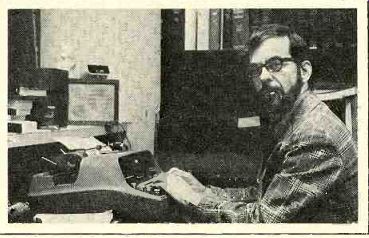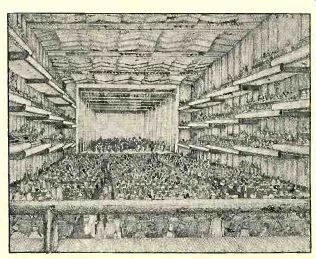
by JAMES GOODFRIEND
THE HALL OF THE HOUSE OF FISHER
LNCOLN CENTER for the Performing Arts held a press conference in New York the other day and handed out a press release: Avery Fisher Hall is to be gutted. Well, they didn't put it exactly that way, but that is definitely what they meant. The outer walls, the staircases, and presumably the hanging sculpture out front will remain, but the auditorium itself will be "demolished and totally reconstructed," and that means not just the seats and the stage, but the very walls, ceilings, and floors. The reasons for this are not hard to find: the place has been an acoustical-and and therefore musical-disaster since opening night.
Philharmonic Hall, which was its name until 1973, was a product of its time, the time of what was even then called the "edifice complex." It was designed to be "different," to knock your eyes out, to be luxuriously comfortable--and to hold a lot of people. Acoustical problems (and it was conceded there might be some) were to be ironed out by "tuning" the hall with specially designed "acoustical clouds" which covered the ceiling.
But, in actual experience, sitting in Philharmonic Hall was rather like sitting in the mouth of a large horn tweeter. The curving walls and ceiling gave a perspective view of the orchestra way down the throat of the horn, and the sound was (as we in the audio game put it) peaked in the high mid-range and definitely rolled off in the bass. The clouds did not per form their intended miracle, and when they were removed-as they were during one of many later alterations-the ceiling itself offered little improvement. Despite some fairly extensive (and expensive) renovations, each of which offered hope and provided disappointment, it began to be apparent that nothing short of gutting the structure and starting all over again was going to make much difference. Some of us, with the sound of the Philharmonic Hall organ in our minds, even thought it ought to be made into a skating rink.
At any rate, this time they are going to give it the works. Following the last concert (May) of the current season, the inside of the hall will be demolished, stripped, and rebuilt, to be finished, it is hoped, in time for the Philharmonic's Pension Fund Concert on October 19. The architect for the new hall is Philip Johnson, and the acoustician (Johnson has al ready referred to him as "my boss," showing that he is aware of what the real problems are) is Cyril M. Harris, who was acoustical consultant for the Kennedy Center in Washing ton, the Krannert Center in Urbana, Orchestra Hall in Minneapolis, and Powell Symphony Hall in St. Louis. The man who put up most of the money for the work is Avery Fisher, the founder of Fisher Radio, for whom the hall was renamed three years ago on the occasion of his initial huge gift to Lincoln Center. Dare we say that here is one more example of the recording and audio-component industry leading the concert business by the nose? There is a certain poetic justice in that, for the old Philharmonic Hall reminded one of nothing more than a cheap, ersatz high-fidelity set.
The primary thing that Harris and Johnson expect to do is to get rid of Fisher Hall's curves and make it into a rectangular room with the ceiling roughly parallel to the floor.
This is dispensing with artificial "modern ism" and going back to the classical concert-hall shape of the eighteenth and nineteenth centuries. The present streamlined curvature of the boxes and balconies will be replaced by three tiers of boxes facing laterally into the hall and three tiers of balconies (of five to six rows of seats each) in a straight line in the back of the hall, overhanging comparatively few of the orchestra seats and presumably making the sound considerably more equal throughout the hall than is presently the case.
The enlarged stage will be framed by a proscenium, the walls will be faced with random-width wood panels, and the ceiling, of painted plaster, will have undulations to provide further break-up of sound. Even the fronts of the boxes will be convex to reflect sound. In other words, no new, experimental techniques are being considered, only designs that have proved effective elsewhere. I note the absence of the carvings and the statuary that are such a noticeable part of many great European concert halls, but, should all else fail, I dare say it would be easy enough to cobble up three dozen miscellaneous wood and plaster nymphs to drop in here and there.
The question is still whether all this will work, for Avery Fisher Hall is quite a gigantic place (the new seating capacity will be 2,726), rather larger than most of the great European halls. Dr. Harris seems quietly confident. He refused to be pinned down to any prediction of what the final acoustics might be like, whether they might resemble those of Carnegie Hall, Boston's Symphony Hall, or even, God forbid, Royal Albert Hall in London. He expressed the wish that everyone at the press conference come to hear the results when the project is finished and make up his own mind, and there is little doubt that that wish, at least, will certainly be granted.
THE New York Philharmonic is one of the world's great orchestras. It is virtually criminal that for fourteen years it has not had a home that was acoustically worthy of it. Visiting orchestras, great instrumental virtuosos, and the best of the world's recital singers have likewise been forced to undergo musically degrading experiences in New York, and the hall's effect on its audiences can only be termed insulting. It is time that things were changed, and one must sympathize with those who are endeavoring to change them and be grateful to those who have made it possible. I think that even Mr. Johnson and Dr. Harris must agree, though, that acoustics is a tricky business, that there may be some sort of spiritual element in it that undercuts the physical.
If in fact the devil has spat on the site, or if those in charge forgot to bury the proper artifacts under the cornerstone of the building, there may be nothing left to do but turn it into the aforementioned skating rink, and, properly invoking the blessings of the gods of music, start all over again elsewhere in town. Say,

---------- Central Park North. Artist's rendering of the proposed new interior of Avery Fisher Hall at Lincoln Center.
Also see:
THE BASIC REPERTOIRE, MARTIN BOOKSPAN